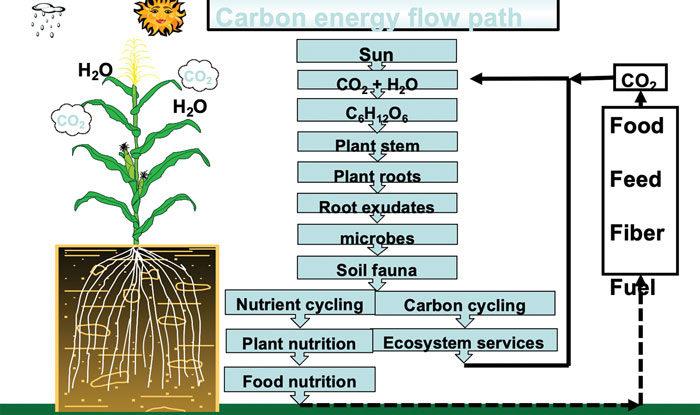No-Till Farmer
Get full access NOW to the most comprehensive, powerful and easy-to-use online resource for no-tillage practices. Just one good idea will pay for your subscription hundreds of times over.

CYCLING CARBON. Through photosynthesis, crops create food in the form of sugar and carbon that is circulated through the soil, into the atmosphere and back to the crop. "Exudates come out of the root system and go into the soil," Jerry Hatfield says. "That's the energy source feeding those microbes that feed then the soil fauna, and we end up with this whole complex thing that happens within the soil that we call carbon cycling." Image: Jerry Hatfield
Carbon is like water and oxygen. Without it, there’s no life,” says Jerry Hatfield, a retired laboratory director for the Department of Agriculture’s Agricultural Research Service. “Without carbon, we would have no soil aggregation. It would still remain as sand, silt and clay. There would be no living component. Carbon is also the energy source for all soil microbiological activity. We are — and we process — carbon. That’s where our energy comes from.”
Carbon creates the structure in biological systems. It is the foundation of all macromolecules, proteins, lipids, nucleic acids and carbohydrates.
“We need to understand that agriculture is part of a very complex ecological system that we need to figure out how to manage,” Hatfield says.
Like water, carbon also cycles through ecosystems as a vital component of soil structure, crop health, nutrient exchange, microbial activity and soil health.
This carbon cycle, or carbon energy flow path, describes the way that carbon moves through a system and facilitates nutrient cycling. As crops photosynthesize, they take in energy from the sun, carbon dioxide and water to create simple sugars to use as food. When the crop grows and builds carbon, 15-40% of that carbon is leaked from the roots to the soil in the form of nutrients to feed the soil microbes, according to Hatfield. Through microbial respiration, carbon dioxide is then released back into the atmosphere to begin the cycle of photosynthesis over again.